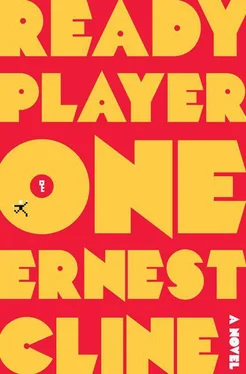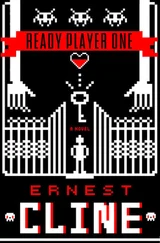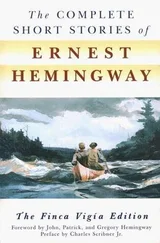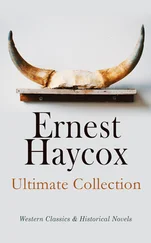Cline Ernest - Ready Player One
Здесь есть возможность читать онлайн «Cline Ernest - Ready Player One» весь текст электронной книги совершенно бесплатно (целиком полную версию без сокращений). В некоторых случаях можно слушать аудио, скачать через торрент в формате fb2 и присутствует краткое содержание. Год выпуска: 2011, ISBN: 2011, Издательство: Crown, Жанр: Старинная литература, на английском языке. Описание произведения, (предисловие) а так же отзывы посетителей доступны на портале библиотеки ЛибКат.
- Название:Ready Player One
- Автор:
- Издательство:Crown
- Жанр:
- Год:2011
- ISBN:9780307887450
- Рейтинг книги:4.67 / 5. Голосов: 3
-
Избранное:Добавить в избранное
- Отзывы:
-
Ваша оценка:
- 100
- 1
- 2
- 3
- 4
- 5
Ready Player One: краткое содержание, описание и аннотация
Предлагаем к чтению аннотацию, описание, краткое содержание или предисловие (зависит от того, что написал сам автор книги «Ready Player One»). Если вы не нашли необходимую информацию о книге — напишите в комментариях, мы постараемся отыскать её.
Ready Player One — читать онлайн бесплатно полную книгу (весь текст) целиком
Ниже представлен текст книги, разбитый по страницам. Система сохранения места последней прочитанной страницы, позволяет с удобством читать онлайн бесплатно книгу «Ready Player One», без необходимости каждый раз заново искать на чём Вы остановились. Поставьте закладку, и сможете в любой момент перейти на страницу, на которой закончили чтение.
Интервал:
Закладка:
Halliday had faithfully re-created every detail of Black Tiger’s eight-level dungeon.
I got off to a rough start and lost a life before I even cleared the first boss. But then I began to acclimate to playing the game in three dimensions (and from a first-person perspective). Eventually, I found my groove.
I pressed onward, leaping from platform to platform, attacking in midair, dodging the relentless onslaught of blobs, skeletons, snakes, mummies, minotaurs, and yes, ninjas. Each enemy I vanquished dropped a pile of “Zenny coins” that I could later use to purchase armor, weapons, and potions from one of the bearded wise men scattered throughout each level. (These “wise men” apparently thought setting up a small shop in the middle of a monster-infested dungeon was a fine idea.)
There were no time-outs, and no way for me to pause the game. Once you entered a gate, you couldn’t just stop and log out. The system wouldn’t allow it. Even if you removed your visor, you would remain logged in. The only way out of a gate was to go through it. Or die.
I managed to clear all eight levels of the game in just under three hours. The closest I came to death was during my battle with the final boss, the Black Dragon, who, of course, looked exactly like the beast depicted in the painting in Anorak’s study. I’d used up all of my extra lives, and my vitality bar was almost at zero, but I managed to keep moving and stay clear of the dragon’s fiery breath while I slowly knocked down his life meter with a steady barrage of throwing daggers. When I struck the final killing blow, the dragon crumbled into digital dust in front of me.
I let out a long, exhausted sigh of relief.
Then, with no transition whatsoever, I found myself back in the bowling alley game room, standing in front of the Black Tiger game. In front of me, on the game’s monitor, my armored barbarian was striking a heroic pose. The following text appeared below him:
YOU HAVE RETURNED PEACE AND PROSPERITY TO OUR NATION.
THANK YOU, BLACK TIGER!
CONGRATULATIONS ON YOUR STRENGTH AND WISDOM!
Then something strange happened—something that had never happened when I’d beaten the original game. One of the “wise men” from the dungeon appeared on the screen, with a speech balloon that said, “Thank you. I am indebted to you. Please accept a giant robot as your reward.”
A long row of robot icons appeared below the wise man, stretching across the screen horizontally. By moving the joystick left or right, I found that I was able to scroll through a selection of over a hundred different “giant robots.” When one of these robots was highlighted, a detailed list of its stats and weaponry appeared on the screen beside it.
There were several robots I didn’t recognize, but most were familiar. I spotted Gigantor, Tranzor Z, the Iron Giant, Jet Jaguar, the sphinx-headed Giant Robo from Johnny Sokko and His Flying Robot , the entire Shogun Warriors toy line, and many of the mechs featured in both the Macross and Gundam anime series. Eleven of these icons were grayed out and had a red “X” over them, and these robots could not be identified or selected. I knew they must be the ones taken by Sorrento and the other Sixers who had cleared this gate before me.
It seemed possible that I was about to be awarded a real, working recreation of whichever robot I selected, so I studied my options carefully, searching for the one I thought would be the most powerful and well armed. But I stopped cold when I saw Leopardon, the giant transforming robot used by Supaidaman , the incarnation of Spider-Man who appeared on Japanese TV in the late 1970s. I’d discovered Supaidaman during the course of my research and had become somewhat obsessed with the show. So I didn’t care if Leopardon was the most powerful robot available. I had to have him, regardless.
I highlighted that icon and tapped the Fire button. A twelve-inch-tall replica of Leopardon appeared on top of the Black Tiger cabinet. I grabbed it and placed it in my inventory. There were no instructions, and the item description field was blank. I made a mental note to examine it later, when I got back to my stronghold.
Meanwhile, on the Black Tiger monitor, the end credits had begun to scroll over an image of the game’s barbarian hero sitting on a throne with a slender princess at his side. I respectfully read each of the programmers’ names. They were all Japanese, except for the very last credit, which read OASIS PORT BY J. D. HALLIDAY.
When the credits ended, the monitor went dark for a moment. Then a symbol slowly appeared in the center of the screen: a glowing red circle with a five-pointed star inside it. The points of the star extended just beyond the outer edge of the circle. A second later, an image of the Crystal Key appeared, spinning slowly in the center of the glowing red star.
I felt a rush of adrenaline, because I recognized the red star symbol, and I knew where it was meant to lead me.
I snapped several screenshots, just to be safe. A moment later, the monitor went dark, and the Black Tiger game cabinet melted and morphed into a door-shaped portal with glowing jade edges. The exit.
I let out a triumphant cheer and jumped through it.

When I emerged from the gate, my avatar reappeared backinside Tyrell’s office. The Voight-Kampff machine had reappeared in its original location, resting on the table beside me. I checked the time. Over three hours had passed since I’d first entered the gate. The room was deserted, save for the owl, and the security klaxons were no longer wailing. The NPC guards must have busted in and searched this area while I was still inside the gate, because they no longer appeared to be looking for me. The coast was clear.
I made my way back to the elevator and up to the landing platform without incident. And thanks be to Crom, the Vonnegut was still parked right where I’d left it, its cloaking device still engaged. I ran on board and left Axrenox, jumping to light speed as soon as I reached orbit.
As the Vonnegut streaked through hyperspace, headed for the nearest stargate, I pulled up one of the screenshots I’d taken of the red star symbol. Then I opened my grail diary and accessed the subfolder devoted to the legendary Canadian rock band Rush.
Rush had been Halliday’s favorite band, from his teens onward. He’d once revealed in an interview that he’d coded every single one of his videogames (including the OASIS) while listening exclusively to Rush albums. He often referred to Rush’s three members—Neil Peart, Alex Lifeson, and Geddy Lee—as “the Holy Trinity” or “the Gods of the North.”
In my grail diary, I had every single Rush song, album, bootleg, and music video ever made. I had high-res scans of all their liner notes and album artwork. Every frame of Rush concert footage in existence. Every radio and television interview the band had ever done. Unabridged biographies on each band member, along with copies of their side projects and solo work. I pulled up the band’s discography and selected the album I was looking for: 2112 , Rush’s classic sci-fi–themed concept album.
A high-resolution scan of the album’s cover appeared on my display. The band’s name and the album’s title were printed over a field of stars, and below that, appearing as if reflected in the surface of a rippling lake, was the symbol I’d seen on the Black Tiger game’s monitor: a red five-pointed star enclosed in a circle.
When I placed the album cover side by side with the screenshot of the game screen, the two symbols matched exactly.
Читать дальшеИнтервал:
Закладка:
Похожие книги на «Ready Player One»
Представляем Вашему вниманию похожие книги на «Ready Player One» списком для выбора. Мы отобрали схожую по названию и смыслу литературу в надежде предоставить читателям больше вариантов отыскать новые, интересные, ещё непрочитанные произведения.
Обсуждение, отзывы о книге «Ready Player One» и просто собственные мнения читателей. Оставьте ваши комментарии, напишите, что Вы думаете о произведении, его смысле или главных героях. Укажите что конкретно понравилось, а что нет, и почему Вы так считаете.




![Эрнест Клайн - Ready Player Two [calibre]](/books/438636/ernest-klajn-ready-player-two-calibre-thumb.webp)







